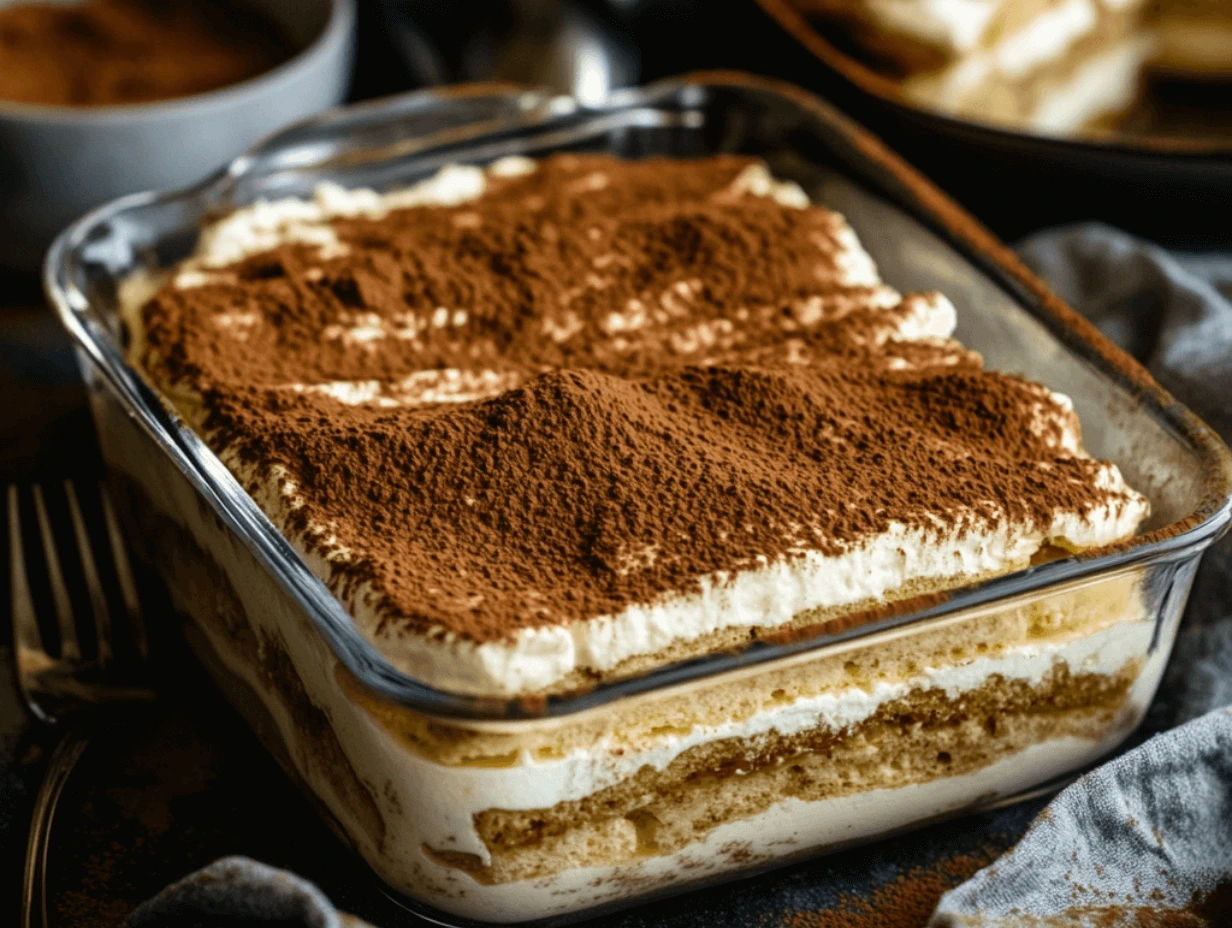Table of contents
Tiramisu, an iconic Italian dessert, is loved worldwide for its rich, creamy texture and the perfect balance of coffee and sweetness. However, despite its seemingly simple recipe, many things can go wrong when making tiramisu. A misstep here or there can turn this beloved dessert into a soggy, overly sweet, or texturally inconsistent dish.
Whether you’re a first-time baker or an experienced chef, knowing what to avoid is just as important as following the recipe. This guide will walk you through the most common mistakes people make when preparing tiramisu and provide tips to ensure your dessert turns out perfect every time.
Mistakes with Ingredients
The heart of a great tiramisu lies in its ingredients. Because this dessert relies on a few simple components, each one must be high quality. Skimping on the essentials or choosing unsuitable substitutes can compromise the dish’s flavor and texture. Let’s dive into common ingredient-related mistakes and how to avoid them.
Using Low-Quality Ingredients
Tiramisu demands premium ingredients for its signature taste. Opting for low-grade products—like cheap coffee, imitation vanilla extract, or low-fat mascarpone—can diminish the depth of flavor and richness the dessert is known for. Always choose authentic, high-quality items such as:
- Mascarpone Cheese: A rich, creamy mascarpone is essential. Avoid cream cheese or whipped toppings as substitutes.
- Espresso: Freshly brewed espresso offers a robust coffee flavor. Instant coffee won’t deliver the same intensity.
- Cocoa Powder: Use unsweetened, high-quality cocoa for dusting. Sweetened cocoa can make the dessert overly sugary.
Skipping the Mascarpone
One of the most common errors is attempting to replace mascarpone cheese with cream cheese or another dairy product. While mascarpone provides a velvety texture and subtle tang, cream cheese can add an unwanted heaviness or tartness that overwhelms the dessert. Stick with authentic mascarpone for an indulgent result.
Choosing the Wrong Coffee
Tiramisu thrives on the bold flavor of strong espresso, which complements the sweetness of the cream mixture. Substituting weak coffee or flavored blends (e.g., hazelnut or vanilla coffee) can throw off the balance of flavors. Brew a fresh batch of espresso or use a high-quality, robust coffee to soak the ladyfingers.
Over-Sweetening
Many tiramisu recipes call for sugar, but overdoing it can result in a cloyingly sweet dessert that loses the harmonious interplay between coffee and cream. To avoid this, measure your sugar carefully and taste-test the mascarpone mixture as you prepare it. Remember, the slight bitterness from the coffee and cocoa should shine through, balancing the sweetness.
Ignoring Alcohol’s Role
Traditionally, tiramisu incorporates a touch of alcohol, such as Marsala wine, rum, or coffee liqueur, to elevate the flavor profile. Skipping this step entirely can leave the dessert tasting one-dimensional. If you prefer a non-alcoholic version, use high-quality vanilla extract or strong espresso as a substitute, but be mindful that it won’t fully replicate the depth of flavor that alcohol provides.
Errors in Preparation

Even with top-quality ingredients, preparation errors can make or break your tiramisu. From improper layering techniques to mistakes in texture, each step requires careful attention. Let’s explore the most common preparation missteps and how to avoid them.
Improper Layering
Layering is the hallmark of a visually and texturally stunning tiramisu. Failing to alternate the layers of soaked ladyfingers and creamy mascarpone evenly can create a lopsided or inconsistent dessert. To ensure a perfect balance:
- Use Uniform Layers: Spread each layer of mascarpone mixture evenly, covering the ladyfingers fully without overloading.
- Maintain Evenness: Place the ladyfingers parallel in each layer for structural integrity. Avoid cramming or overlapping them haphazardly.
Over-Soaking the Ladyfingers
A critical error in tiramisu-making is over-soaking the ladyfingers (savoiardi) in coffee or coffee-alcohol mixtures. When ladyfingers absorb too much liquid, they become soggy and lose their shape, turning the dessert into a mushy mess. To prevent this:
- Quickly dip each ladyfinger in the coffee mixture for just 1-2 seconds.
- Avoid leaving them in the liquid to soak, as they absorb moisture rapidly.
Incorrect Whipping of Mascarpone Mixture
The mascarpone mixture’s texture is essential for achieving the creamy, luscious layers characteristic of tiramisu. Common errors include under-whipping, which leads to a runny mixture, or over-whipping, which can cause the mascarpone to curdle. To get it right:
- Use cold ingredients, particularly cream and mascarpone, to stabilize the mixture.
- Beat until the mixture is smooth and forms soft peaks, avoiding over-mixing.
Misjudging the Balance of Ingredients
Achieving the right balance of flavors is an art. Some recipes call for too much coffee, which can overwhelm the dessert, or too little, which leaves it bland. Similarly, excessive cocoa dusting can overpower the mascarpone’s delicate flavor. Always taste-test each component before assembling the tiramisu to ensure the balance of sweetness, coffee, and creaminess is just right.
Ignoring the Recipe Instructions
While tiramisu recipes often leave room for creative interpretation, ignoring key details can lead to disaster. For instance, skipping the step of separating and beating egg whites to stiff peaks (in traditional recipes) can result in a dense mascarpone mixture. Always follow the recipe carefully, especially if you’re making tiramisu for the first time.
Skipping Steps
Tiramisu is a dessert that rewards patience. While it might be tempting to skip or rush certain steps, doing so can compromise the final result. From preparation to chilling, every step plays a critical role in creating a dessert that lives up to its reputation.
Neglecting to Chill the Tiramisu
One of the biggest mistakes is serving tiramisu too soon. This dessert requires at least 6–8 hours of chilling time, and ideally overnight, for the flavors to meld and the layers to set properly. Skipping this step results in a dessert that is runny, uneven, and lacking depth of flavor. To avoid this, always prepare tiramisu well in advance of serving.
Failing to Use Fresh Ingredients
The freshness of ingredients, particularly eggs and cream, is non-negotiable when making tiramisu. Stale or near-expiration ingredients can not only affect the taste and texture but also pose food safety risks. Always use:
- Fresh Eggs: Essential for traditional recipes, as they are used raw in the mascarpone mixture.
- Fresh Cream: If your recipe calls for whipped cream, ensure it’s fresh and full-fat for stability.
Skipping the Egg Safety Step
Traditional tiramisu recipes use raw eggs, which can raise concerns about food safety. Skipping this consideration can lead to health risks. To make a safe and delicious tiramisu:
- Use pasteurized eggs to reduce the risk of bacteria.
- Alternatively, make a zabaglione (a cooked custard base) by gently heating the egg yolks with sugar over a double boiler before mixing with mascarpone.
Overlooking Proper Assembly
Rushing through the assembly process is another common error. Each layer needs care and precision. For example:
- Even Distribution: Spread the mascarpone mixture evenly across the ladyfingers to avoid pockets of dryness or sogginess.
- Layer Order: Always follow the sequence: soaked ladyfingers, mascarpone mixture, cocoa dusting. Repeat as needed to build the dessert.
Ignoring the Recipe’s Timing
Tiramisu recipes often provide specific timelines for steps like soaking the ladyfingers or chilling the dessert. Ignoring these can lead to issues like overly dry layers, uneven texture, or flavors that haven’t properly combined. Stick to the recommended timings for optimal results.
Storage and Serving Mistakes

Once your tiramisu is prepared, proper storage and serving techniques are essential to preserve its quality and ensure the best possible experience. Mistakes in this final stage can undo all your hard work.
Storing Tiramisu Incorrectly
Tiramisu is a delicate dessert that requires proper storage to maintain its texture and flavor. Common storage errors include:
- Leaving It at Room Temperature: Tiramisu contains perishable ingredients like mascarpone and eggs, which can spoil quickly if left unrefrigerated. Always store tiramisu in the refrigerator.
- Improperly Covered: Failing to cover tiramisu can cause it to dry out or absorb odors from the fridge. Use cling film or an airtight container to keep it fresh.
- Freezing Without Preparation: While tiramisu can be frozen for longer storage, doing so without proper steps (like wrapping tightly in plastic and foil) can lead to freezer burn and affect the texture.
Serving It Too Soon
Rushing to serve tiramisu before it has had sufficient time to chill is a common mistake. Without adequate chilling time, the dessert will be runny, and the flavors won’t have melded. Aim for at least 6–8 hours of refrigeration, but overnight chilling yields the best results.
Serving Tiramisu Frozen
While freezing tiramisu can extend its shelf life, serving it directly from the freezer is a mistake. Frozen tiramisu loses its creamy texture, making it more like an icebox cake than a classic dessert. Always allow frozen tiramisu to thaw in the refrigerator for several hours before serving to restore its intended texture.
Cutting It Improperly
Tiramisu’s delicate layers require gentle handling when slicing and serving. Common mistakes include using a dull knife or cutting uneven portions. To avoid these pitfalls:
- Use a sharp knife or spatula for clean slices.
- Wipe the knife between cuts to maintain neat edges.
- Serve with care, using a wide spatula to lift portions without collapsing the layers.
Overcomplicating Presentation
While garnishing with cocoa powder or grated chocolate is traditional and adds to the dessert’s appeal, overloading with extra toppings like whipped cream, caramel, or fruits can detract from its elegant simplicity. Stick to classic enhancements for an authentic presentation.
Common Misconceptions
Tiramisu’s simple recipe often leads to misunderstandings about what can and cannot be substituted or altered. These misconceptions can affect the dessert’s authenticity and quality. Let’s address some of the most frequent errors in interpretation.
Substituting Key Ingredients
While it might be tempting to swap out traditional ingredients for what’s readily available, certain substitutions can ruin the integrity of tiramisu. For example:
- Ladyfingers: Replacing savoiardi with soft cookies can result in a mushy dessert since they won’t hold their shape after soaking.
- Mascarpone: Using cream cheese or ricotta alters the flavor and texture significantly. Stick with mascarpone for the authentic richness.
- Espresso: Substituting with regular drip coffee reduces the intensity of flavor.
Misinterpreting Traditional Recipes
Some recipes omit key details, like the necessity of chilling or the importance of using specific ingredients. Misunderstanding these recipes can lead to shortcuts that compromise the outcome. Always rely on authentic recipes that specify traditional techniques and ingredients.
Using Shortcuts
With tiramisu, shortcuts often lead to poor results. Examples include:
- Premade Layers: Buying pre-assembled layers or instant tiramisu mixes sacrifices the freshness and flavor of homemade components.
- Skipping the Soak: Some might try to skip soaking the ladyfingers entirely, resulting in dry layers without the signature coffee flavor.
Frequently Asked Questions
Can I Make Tiramisu Without Alcohol?
Yes, you can make tiramisu without alcohol by omitting Marsala wine, rum, or liqueur. Substitute with strong vanilla extract or simply enhance the espresso flavor. However, note that alcohol adds depth, so the dessert may taste less complex.
How Do I Ensure Egg Safety?
For recipes using raw eggs, opt for pasteurized eggs to reduce the risk of salmonella. Alternatively, use a cooked custard base (zabaglione) to incorporate eggs safely.
Can I Use Vegan Alternatives?
Yes, vegan tiramisu is possible using plant-based mascarpone alternatives, non-dairy whipped cream, and egg substitutes. For the ladyfingers, use vegan sponge cakes or biscuits. While the flavor and texture may differ, it’s a viable option.
Conclusion
Making tiramisu is an art that combines quality ingredients, precise techniques, and a little patience. By avoiding common mistakes like over-soaking ladyfingers, skipping key steps, or using improper storage methods, you can create a tiramisu that is as close to perfection as possible. Whether you’re crafting a traditional version or experimenting with variations, attention to detail is what makes this dessert shine.





